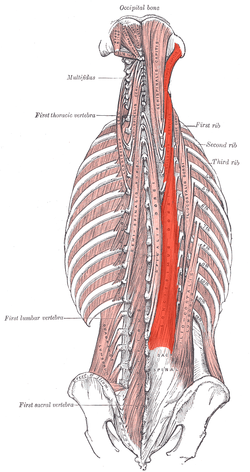Longissimus Thoracis
Original Editor - Oyemi Sillo
Lead Editors - Oyemi Sillo, Kim Jackson, Lucinda hampton, WikiSysop and 127.0.0.1
Description[edit | edit source]
The longissimus muscle is a long intrinsic muscle of the back. Along with spinalis and iliocostalis, these three muscles comprise the erector spinae group. [1] It is divided into three parts (capitis, cervicis, thoracis) based on their superior attachments and location. The erector spinae muscles, including longissimus, are the most powerful extensors of the vertebral column[1].
Origin[edit | edit source]
The common broad, thick tendon with Iliocostalis Lumborum, fibers from the transverse and mamillary processes of the lumbar vertebrae and lumbrosacral aponeurosis[2]
Insertion[edit | edit source]
The tips of transverse process of all thoracic vertebrae and the lower 9 or 10 ribs between the tubercles and angles [2]
Nerve Supply[edit | edit source]
Dorsal rami of thoracic and lumbar spinal nerves (T7 to L5) [3]
Blood Supply[edit | edit source]
Dorsal branches of the posterior intercostal arteries from the thoracic aorta. [3]
Action[edit | edit source]
Acting
- unilaterally, extension of vertebral column and flexion to the same side
- bilaterally, extension and hyperextension of vertebral column[2]
Function[edit | edit source]
Draws ribs down to help with breathing[3]
References[edit | edit source]
- ↑ 1.0 1.1 Ken Hub Longissimus Available: https://www.kenhub.com/en/library/anatomy/longissimus-muscle(accessed 5.2.2022)
- ↑ 2.0 2.1 2.2 http://www.wheelessonline.com/ortho/longissimus_thoracis_1
- ↑ 3.0 3.1 3.2 http://www.anatomyexpert.com/app/structure/5230/








